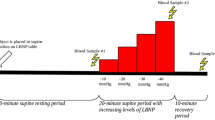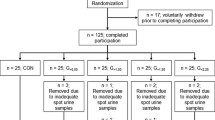Abstract
Immersion is a useful tool for studying fluid-volume homeostasis. Natriuretic peptides play a vital role in renal, humoral, and cardiovascular regulation under changing environmental conditions. We hypothesized that dry immersion would rapidly induce a new steady state for water and sodium metabolism, and that serum NT-proBNP levels, a proxy measure for brain natriuretic peptide (BNP), would decrease during long-term dry immersion and increase during recovery. Eight healthy young men were studied before, during, and after 7 days of dry immersion. Body weight, water balance, and plasma volume changes were evaluated. Plasma and serum samples were analyzed for active renin, NT-proBNP, aldosterone, electrolytes, osmolality, total protein, and creatinine. Urine samples were analyzed to determine levels of electrolytes, osmolality, creatinine, and free cortisol. A stand test was performed before and after dry immersion to evaluate cardiovascular deconditioning. Long-term dry immersion induced acute changes in water and sodium homeostasis on day 1, followed by a new steady state. Plasma volume decreased significantly during dry immersion. The serum levels of NT-proBNP increased significantly in recovery (10 ± 3 ng/L before dry immersion vs. 26 ± 5 ng/L on the fourth recovery day). Heart rate in the standing position was significantly greater after immersion. Results suggest that chronic dry immersion rapidly induced a new level of water-electrolyte homeostasis. The increase in NT-proBNP levels during the recovery period may be related to greater cardiac work and might reflect the degree of cardiovascular deconditioning.




Similar content being viewed by others
References
Anashkin OD, Beliaev SM (1982) Effect of sidnocarb during 7-day water immersion on the cardiorespiratory system under physical load. Kosm Biol Aviakosm Med 16:28–31 (Russian)
Belin de Chantemele E, Gauquelin-Koch G, Duvareille M, Pellet N, Gharib C, Custaud MA (2006) Blood volume measurement: the comparison of pulse dye densitometry and Dill and Costill’s methods. Life Sci 78:1564–1569
Cauliez B, Berthe MC, Lavoinne A (2005) Brain natriuretic peptide: physiological, biological and clinical aspects. Ann Biol Clin (Paris) 63:15–25
Epstein M (1996) Renal, endocrine and hemodynamic effects of water immersion in humans. In: Handbook of physiology. Environmental physiology. Am. Physiol. Soc., sect. 4, vol. II, chapt. 37, New York, Oxford, pp 845–853
Eshmanova AK (2009) Heart rate variability and myocardium state: effect of “dry” immersion. PhD dissertation [in Russian], Institute of Biomedical Problems, Moscow, Russia
Gogolev KI, Aleksandrova EA, Shul’zhenko EB (1980) Comparative assessment of changes during antiorthostatic hypokinesia and immersion in man. Hum Physiol 6:392–396 (Russian)
Greenleaf JE (1984) Physiological responses to prolonged bed rest and fluid immersion in humans. J Appl Physiol 57:619–633
Grigor’ev AI, Kozlovskaia IB, Shenkman BS (2004) The role of support afferents in organisation of the tonic muscle system. Ross Fiziol Zh Im I M Sechenova 90:508–521 (Russian)
Iunusov MA, Orlov VN, Vinokhodova TV (1985) Effect of the model of “dry” immersion on the indicators of water-electrolyte metabolism and aldosterone and cortisol in the plasma of persons with different levels of body water. Kosm Biol Aviakosm Med 19:42–45 (Russian)
Iwase S, Sugiyama Y, Miwa C et al (2000) Effects of three days of dry immersion on muscle sympathetic nerve activity and arterial blood pressure in humans. J Auton Nerv Syst 79:156–164
Levine BD, Zuckerman JH, Pawelczyk JA (1997) Cardiac atrophy after bed-rest deconditioning: a nonneural mechanism for orthostatic intolerance. Circulation 96:517–525
Perhonen MA, Franco F, Lane LD et al (2001) Cardiac atrophy after bed rest and spaceflight. J Appl Physiol 91:645–653
Scharhag J, George K, Shave R et al (2008) Exercise-associated increases in cardiac biomarkers. Med Sci Sports Exerc 40:1408–1415
Shulzhenko EB, Vil-Vilyams IF (1976) The possibility to maintain a long term water immersion by using the method of “dry immersion”. Kosm Biol Aviakosm Med 10:82–84 (Russian)
Shulzhenko EB, Tigranyan RA, Panfilov VE, Bzhalava II (1980) Physiological reactions during acute adaptation to reduced gravity. Life Sci Space Res 18:175–179
Somody L, El Fazaa S, Gharbi N et al (1999) Immersion physiology: a current look at an ancient treatment. Presse thermale et climatique 136:181–187 (French)
Stadeager C, Johansen LB, Warberg J et al (1992) Circulation, kidney function, and volume-regulating hormones during prolonged water immersion in humans. J Appl Physiol 73:530–538
Thaman R, Esteban MT, Barnes S et al (2006) Usefulness of N-terminal pro-B-type natriuretic peptide levels to predict exercise capacity in hypertrophic cardiomyopathy. Am J Cardiol 98:515–519
Tokola H, Hautala N, Marttila M et al (2001) Mechanical load-induced alterations in B-type natriuretic peptide gene expression. Can J Physiol Pharmacol 79:646–653
Truijen J, Bundgaard-Nielsen M, van Lieshout JJ (2010) A definition of normovolaemia and consequences for cardiovascular control during orthostatic and environmental stress. Eur J Appl Physiol 109:141–157
Wu AH, Smith A, Wieczorek S, Mather JF et al (2003) Biological variation for N-terminal pro- and B-type natriuretic peptides and implications for therapeutic monitoring of patients with congestive heart failure. Am J Cardiol 92:628–631
Acknowledgments
The authors wish to thank the volunteers for their participation in this dry immersion protocol at the IBMP in 2006–2007. We are grateful to Jackie Godfrey for the syntax review. This work was supported by a PhD grant from the French Embassy in Belarus to N. Navasiolava. This study was supported by Centre National d’Etudes Spatiales (CNES), Centre National de la Recherche Scientifique (CNRS) and Region des Pays de la Loire.
Conflict of interest
The authors declare that they have no conflict of interest.
Author information
Authors and Affiliations
Corresponding author
Additional information
Communicated by Dag Linnarsson.
Rights and permissions
About this article
Cite this article
Navasiolava, N.M., Pajot, A., Gallois, Y. et al. NT-ProBNP levels, water and sodium homeostasis in healthy men: effects of 7 days of dry immersion. Eur J Appl Physiol 111, 2229–2237 (2011). https://doi.org/10.1007/s00421-011-1858-7
Received:
Accepted:
Published:
Issue Date:
DOI: https://doi.org/10.1007/s00421-011-1858-7




